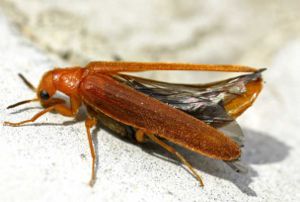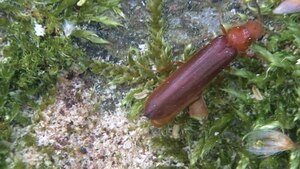Saw-horned shipyard beetle
| Saw-horned shipyard beetle | ||||||||||||
|---|---|---|---|---|---|---|---|---|---|---|---|---|

Saw-horned shipyard beetle ( Hylecoetus dermestoides ) |
||||||||||||
| Systematics | ||||||||||||
|
||||||||||||
| Scientific name | ||||||||||||
| Hylecoetus dermestoides | ||||||||||||
| ( Linnaeus , 1761) |
The saw-horned shipyard beetle ( Hylecoetus dermestoides ) is a beetle from the shipyard beetle family (Lymexylidae).
features
The beetles are 6 to 18 millimeters long, the females are yellow-brown in color, the males are very variable in color, but mostly black. The males have peculiarly shaped maxillary palps (jaw palps), which have a large outgrowth with many long side branches on the second segment, which with their numerous sensory hairs are intended to be used to locate the females. The pronotum of the beetles is edged (thickened) on the sides and they have a small, light-colored grain on their foreheads.
The larvae are 14 to 20 millimeters long and have a slender, whitish and soft body. Their mandibles are spoon-shaped and they have no eyes. Noticeable on her body is the prothorax , which is extended forward like a hood, and the last abdominal segment that ends in a long point. This tip distinguishes them from the similar shipyard beetles ( Lymexylon navale ), which do not have them.
Similar species
- Hylecoetus flabellicornis ( Schneider , 1791). Rare. Head without croissant.
Occurrence
The animals are found all over Europe, although they are less common in southern Europe .
Way of life
The beetles are found in early April to June, and they only live for two to four days.
Food of larvae
The larvae live in almost all deciduous and coniferous trees , but especially in beech , oak , birch , spruce and fir . They eat the hyphae of the fungus Endomyces hylecoeti , which they can scrape off with their specially shaped mandibles.
development
The females lay a total of around 100 eggs in groups of 6 to 40 on the bark or in cracks of trees, especially from May to June. They do this on the shady side of freshly felled trunks or tree stumps that must still be damp. They rarely attack trees that are still alive, which are then severely weakened. The female smears fungal spores on the laid eggs, which she carries with her in special pockets on the laying tube . The larvae hatch after 10 to 14 days, usually in June. At the beginning they roll around in the spores so that their body is covered with it. Then they drill into the wood and distribute the spores on the inner walls of the corridors. Their gaits are very fine at the beginning, but become larger as the animals grow. The tunnels quickly turn black with the growing mushrooms and usually run radially into the trunk, but rarely parallel to the surface, and become approx. 30 centimeters long. In contrast to the shipyard beetles ( Lymexylon navale ), the larvae eject the wood flour through the borehole with the help of abdominal processes so that the fungi can grow. They close the borehole during the winter. After two to three years of development, in exceptional cases in the same year, the larvae are fully grown. However, they usually pupate after one or two hibernations in April near the borehole at a widened point in the passage under a bark cover. This doll's cradle is closed on the inside with drilling dust. The beetles hatch after about seven days.
Harmful effect
The saw-horned shipyard beetles are important for the decomposition of dead wood, but they can cause great damage in forestry. The infestation can be recognized by the differently sized boreholes, which are caused by the fact that the larvae create smaller drill dust ejection holes in addition to the boreholes. You can find drill dust around these holes when you remove the bark. In addition, the tunnels are colored black by the mushroom. Infestation can be avoided by quickly transporting felled wood out of the forest and storing it in dry and ventilated places. Once dried, wood is no longer attacked.
literature
- Jiři Zahradník, Irmgard Jung, Dieter Jung et al .: Käfer Central and Northwestern Europe , Parey Berlin 1985, ISBN 3-490-27118-1
- Edmund Reitter : Fauna Germanica - The beetles of the German Empire. Volume 3 p. 299, KG Lutz, Stuttgart 1911
- Edmund Reitter: Fauna Germanica - The beetles of the German Empire. 5 volumes, Stuttgart KG Lutz 1908 - 1916, digital library volume 134, Directmedia Publishing GmbH, Berlin 2006, ISBN 3-89853-534-7
Web links
- Hylecoetus dermestoides (Linnaeus, 1761) Saw-horned shipyard beetle - Large timberworm ( Memento from July 4, 2008 in the Internet Archive )
- Hylecoetus dermestoides in Fauna Europaea
